

Join SCS Engineers professionals at the Urban Land Institute’s (ULI) Spring Meeting, April 9-11, at the New York Hilton Midtown in New York City.
The conference features some 4,500 real estate professionals, over 30 development tours, 40+ educational sessions, and more than 100 speakers. By attending, you can gain access to a global network of senior resl estate professionals from all corners of the industry.
The Resilience Summit is ULI’s flagship climate adaptation event; convening industry leaders in real estate and resilience from around the world to address the challenges and harness the opportunities posed by climate risks.
Introduction
Contamination at thousands of shopping centers across California from previous business operations presents problems for property owners who wish to continue commercial use, redevelop, and maintain property value. Commercial property remediation targets returning these buildings and land to predevelopment conditions, presenting opportunities for reuse and redevelopment.
One property owner discovered that securing adequate funding and working closely with state and regional regulatory agencies leads to success despite changing regulations and oversimplifying regulatory health risk assessment methods. The Draft Cal-EPA Supplemental Vapor Intrusion Guidance (DSVIG) suggests changes to the methods in which vapor phase transport and potential health risks are modeled and calculated for occupants of buildings with known soil or groundwater contamination beneath them. These changes, the result of a multi-year working group collaboration, recommend an arguably more conservative calculation of indoor air quality. The changes rely on EPA work and guidance, with empirically derived attenuation factors (AFs), which will increase the number of sites requiring additional environmental assessment and mitigation to achieve health risk standards. Although the DSVIG is currently draft guidance, there is evidence that regional regulatory agencies have already adopted AFs in calculating indoor air quality.
Diamond Bar Commercial Center Assessment and Mitigation
Drucker Survivors Trust owns and operates a multi-tenant commercial building in Diamond Bar, California, including a dry cleaner at one time. The former cleaners caused an unauthorized release of dry cleaning solvent containing chlorinated volatile organic compounds to the subsurface during its operation.
Financing for this all too common situation requires environmental due diligence in the form of research commonly completed in a Phase I Environmental Site Assessment followed by an assessment to characterize potential liabilities associated with chlorinated solvent releases before lenders provide funding.
Regulatory oversight in California can either be voluntarily engaged or involuntarily if assessment activities on an adjacent or nearby property indicate the presence of chlorinated volatile organic compounds in the subsurface linked to dry cleaning operations in the vicinity.
The Drucker Survivors Trust sought approval from the applicable regulatory agency, Los Angeles Regional Water Quality Control Board (LARWQCB), to assess and mitigate the chlorinated solvent release to ensure the protection of human health and reduce environmental liabilities associated with the property.
Regulatory closure is the acceptance of assessment and remediation activities by the governing regulatory entity to bring the site into compliance. Compliance, in this case, required assessment and mitigation of beneficial use groundwater underlying the property impacted by the solvent release and completing soil vapor assessment and health risk screening calculations under current state and federal guidelines.
Guidance on vapor assessment and associated health risk screening methods have changed rapidly in California state environmental regulations. As environmental engineers and consultants, SCS professionals manage an extensive list of vapor assessment, health risk assessment, and vapor intrusion mitigation projects resolving these vapor–related issues.
To start this project, the SCS team prepared a successful grant application securing more than $650,000 in funding from the California State Water Resources Control Board’s Site Cleanup Subaccount Program (SB 445, established in 2014). This state-provided grant money enables the assessment and mitigation necessary to close with the LARWQCB.
Subsurface assessment activities defined the extent and scale of chlorinated solvent impacts to soil vapor, soil, and groundwater, enabling the design of a remediation program. To reduce the groundwater contamination to cleanup levels set by the LARWQCB, SCS Engineers designed and implemented an injection program to deliver engineered chemicals directly to the groundwater plume. The injected chemicals destroy the chlorinated solvents via in situ chemical reduction and stimulation of biological degradation.
While challenging drilling conditions precluded previous consultants from attempting groundwater remediation, SCS industry experts safely achieved up to a 99 percent concentration reduction within the groundwater plume. SCS designed a soil vapor assessment that relied more on site-specific data collection and less on conservative default assumptions while conforming to the most current regulatory guidance targeted at minimal impact on the building tenants.
SCS managed all aspects of the project, including grant requirements and communication between the client, regional and state water board staff, city staff, and subcontractors. Obtaining and managing entrance under state waste discharge requirements is necessary, and SCS completed all necessary permitting and reporting requirements to facilitate the groundwater mitigation activities. Careful planning and experience with similar projects minimized impacts on tenants and kept the project on a strict timeline with no missed regulatory deadlines. SCS continues working with the LARWQCB to conclude the client’s final closure requirements and is in the process of applying for an additional $900,000 in SCAP funding to implement the final stages of the project targeted at obtaining final regulatory closure.
Changes Coming to Regulatory Guidance
Recent changes to regulatory guidance in California are arguably making obtaining closure on sites with vapor intrusion health risk concerns more difficult to achieve. The Draft Cal-EPA Supplemental Vapor Intrusion Guidance (DSVIG) suggests changes to the methods in which vapor phase transport and potential health risks are modeled and calculated for occupants of buildings with known soil or groundwater contamination beneath them. These changes, which result from a multi-year working group collaboration, recommend a more extensive and site-specific data collection effort. They include indoor air quality calculation methods relying on EPA work and guidance and empirically derived attenuation factors (AFs) which some would argue lead to overestimating potential health risks.
The consequences of the DSVIG are potentially significant if adopted as is and appear likely to result in more sites being “screened in” with vapor intrusion issues and more sites requiring mitigation. The impact, resultant costs, and possibly detrimental secondary effects such as decreases in affordable housing production, particularly in urban infill areas. And while none would argue with appropriate protection of health risk, the question is whether the studies and empirical data used to support the DSVIG represents the best available science and is truly representative and predictive of risk.
The DSVIG adopts an attenuation rate of 0.03 for the flux of both soil and sub-slab vapor to indoor air based on a previous 2012 EPA Study comprised of empirical data collected from buildings arguably not representative of modern construction in California.
The development of a reliable screening level attenuation factor for California based on high-quality, recent, California-specific data:
1) Will be protective of human health, as no toxicological imperative or basis supports a call for accelerated or immediate action (as evidenced by the fact that the DSVIG workgroup commenced its work in 2014 and issued the review draft in 2020).
2) Will ensure California’s environmental policy satisfies the gold standard for data quality and insightful analysis in which the state once took pride.
3) Will not unnecessarily decimate the California housing development market. The empirically derived screening level AF in the DSVIG is overly conservative based on the available data. More accurate empirical data and measurement methods for site-specific measurement are available.
With respect, oversimplifying the VI health risk assessment methods has constrained the environmental community’s ability to apply science-based health risk screenings, often resulting in costs associated with additional environmental assessment and mitigation. An additional revision to the DSVIG to utilize a screening level AF more reflective of the current California data and building specifications could save state resources, increase infill development by reducing urban sprawl, promote housing development, all while protecting human health.
About the Author: Keith Etchells is a professional geologist and hydrogeologist with over two decades of experience assisting clients in managing environmental risks associated with ownership, transfer, or operation of commercial, industrial, and waste disposal properties. His particular technical expertise involves aspects of groundwater science and engineering relevant to contaminated sites and landfills, including supervision and conduct of subsurface data acquisition, remedial design and implementation, conceptual site model development, aquifer testing, extraction well design, groundwater quality evaluation and treatment, vapor intrusion health risk assessment and mitigation, predictive modeling, and contaminated soil and groundwater remediation design.
He is responsible for designing analytical, geotechnical, and hydrogeological data collection programs to complete subsurface assessment and remediation. He has prepared subsurface assessment documents, property mitigation plans, vapor intrusion risk assessment documents, soil management plans, aquifer characterization documents, conceptual site models, and groundwater remedial design and implementation documents.
Michael W. (Mike) McLaughlin has been elected to the Virginia State Bar Environmental Law Section Board of Governors. His four-year term began on July 1. Mike began his career with SCS as a summer intern as a rising sophomore at Virginia Tech. After receiving his civil (environmental) engineering degree, he received his J.D. from Washington & Lee University School of law. He has been with SCS ever since, applying his combination of law, science, and engineering expertise to environmental matters. His knowledge helps businesses and communities protect air, water, and land resources while serving the needs of their clients or constituents.
McLaughlin recalls his early career choices: “It was exciting to work on some of the earliest research projects sponsored by the then-new Environmental Protection Agency. I chose W&L Law because it had Professor Andrew (Uncas) McThenia on its faculty. Uncas was a Virginia State Water Control Board member and taught one of the few environmental law classes in the country. When I told him he was the reason I came to W&L, Uncas apologized and said he would not teach environmental law anymore—the field had too much politics involved. That was an early and important lesson for me.
“Not to worry,” says Mike. “Turner Smith of the Hunton & Williams law firm taught the environmental law class; he was one of the country’s most well-known Clean Air Act attorneys. His knowledge of the subject matter and teaching ability inspired several of us to seek careers in the field.”
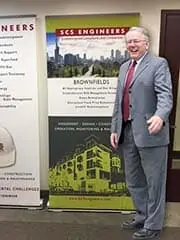
Mike is SCS Engineers’ Senior Vice President of Environmental Services. He advises developers, contractors, lenders, and land development professionals on the technical and regulatory requirements for construction on brownfield sites nationwide. Landfill redevelopment is an area of special interest. His combined engineering and legal background provides an unusual perspective on land development where hazardous wastes or other environmental challenges are present.
In addition to his extensive brownfield redevelopment experience in North America, Mike has worked at more than three dozen Superfund National Priorities List sites in 17 states and on scores of regulatory compliance, voluntary cleanup, and remediation projects for commercial, industrial, municipal, and military clients. His work for electric utilities began in 1980 with research on upgrading solid waste management and has evolved to support greenhouse gas mitigation measures and support the transition to renewable energy.
Mike’s new role with the VSB builds on his decades of experience with the American Bar Association Section of Environment, Energy, and Resources, where he is completing a two-year term as Budget Officer and a member of the Executive Committee.
Here at SCS, we work for developers, industry, and manufacturers to help them run cleaner, safer, and more efficiently. This PBS video provides insight into how SCS brings value to the waste industry, our clients, and, most importantly, our communities.
You may ask yourself, don’t pig farms create pollution? Yes, but even that waste is reusable!
Did you know the food you buy in the grocery is supported by our environmental experts? Learn more about SCS’s environmental engineers and consultants who bring contaminated properties back to life, lower and capture greenhouse gases for fuels and renewable energy, and make possible a brighter future.
If you are interested in becoming an SCS Engineers employee-owner, watch our comprehensive video to see the breadth of services our teams offer.
Vapor intrusion is a regulatory hot button gaining traction on states’ radar nationwide. This is driven by a growing understanding of how vapors travel through the soil into structures, posing health risks to occupants, coupled with research showing volatile vapors can be problematic even at very low concentrations.
As in California, conservative assumptions by regulatory agencies call for careful due diligence during the assessment process. These salient concerns recently brought a real estate developer in Monrovia to seek a professional engineer.
The client plans to convert a commercial property to residential use. But before moving forward, it needs to assess potential environmental issues associated with the property. That’s where SCS comes in, drawing on its concrete knowledge base in geology and chemistry—and leveraging its grasp of regulatory requirements.
The work in Monrovia entails a detailed soil vapor assessment, looking for volatile organic compounds (VOCs); the discovery at this site came as little surprise to Julio Nuno, Senior Vice President, and Project Director, as these constituents are often found during evaluations of this kind.
Assessing for VOCs
In this case, the soil contained eight VOCs, some at non-compliant levels. The good news is, after an extensive, multi-step vetting process, Nuno and his team came up with a relatively inexpensive solution to tackle a potentially daunting problem.
“As part of the soil vapor assessment, we compare concentrations we find on-site to screening levels established by the Department of Toxic Substances Control. We often see levels in exceedance of regulatory thresholds, particularly in industrial areas with releases that can travel from groundwater to soil into the building through the slab,” Nuno says.
Most prominent at the Monrovia site were two chlorinated compounds that have been used as solvents in industrial applications: tetrachloroethylene, also called PCE, and trichloroethene, or TCE. PCE is commonly present in industrial settings and communities as drycleaners widely and routinely used the chemical for decades.
Nevertheless, the work begins even before confirming VOC levels and other specifics around these compounds. The first step is a Phase I Environmental Assessment looking to see if past use of the property or surrounding property may have left a significant environmental impact. The SCS team discovered the adjacent property had a release of VOCs they identified as a ‘recognized environmental condition,’ meaning it needs further evaluation using a Phase II to determine if vapors could migrate onto the client’s property.
During the Phase II Environmental Assessment –the collection of soil and soil vapor samples –the SCS team gets even more specific, determining what’s present, specific locations, what degree of contamination, and what these findings mean for redeveloping the property and its final use.
“We confirm subsurface concentrations and if they exceed state screening levels, and if the site represents a potential risk for future residential use. The information informs our possible solutions to mitigate any migration of certain VOCs into the building and the indoor air,” Nuno explains.
Redevelopment Goals – safety and cost containment
Safety comes first, but containing project costs is a priority, which comes down to knowing design options, how to piece components together with both function and economics in mind. At this site, achieving safety and controlling costs centered largely around looking at the mandatory infrastructure– a ventilation system for a planned underground parking garage to prevent accumulation of carbon monoxide and other vehicle exhaust emissions.
“We knew the underground parking would require a ventilation system. It makes sense to look at the parameters associated with that design to verify if it serves dual purposes to ventilate the garage and mitigate the potential for VOCs to enter the building,” Nuno says.
By studying air exchanges that would occur, the number of times replacing air-containing pollutants with cleaner air per hour, Nuno gets his answer. “We determined that a second, separate system would not be necessary for sufficient ventilation; the assessment enabled us to confirm vapors would not travel into the residential portion of the building.”
The client can save $50,000 to $75,000 in capital expenses upfront while achieving their safety goals and avoids ongoing operations and maintenance costs for added infrastructure.
An added layer of protection
Identifying the issues for site developers and their tenants, then plotting the best course of action to ensure safety and regulatory compliance takes experience and knowledge. SCS devises a soil monitoring plan, alerting developers of indications of potential contamination to the soil, of odor, or anything unusual that could suggest an environmentally adverse condition. The plan advises on how to respond should there be an unexpected condition adding a further protection layer.
“It’s essential that an engineer understand the applicable federal, state, and local standards for completing assessments, as well as understand regulatory stipulations. You must also know the variations in those stipulations to effectively design a sustainable plan,” Nuno says. “In Monrovia, we comply with the Department of Toxic Substances Control requirements, the requirements of the Los Angeles Regional Quality Control Board, and others. Each has specific stipulations for evaluating each contaminant. So, we stay on top of which rules apply to which location,” he says.
Nuno has submitted a draft report for review by his client and its legal counsel; he’ll meet with them to discuss findings and explain their meaning. SCS includes an executive summary, explaining in plain language what is salient; often, a backup report includes thousands of pages. “It’s a lot of complex information, so we work on the language,” Nuno says.
“It’s important to paint an accurate picture and use terms that all parties, whether the client, investors, or other stakeholders understand. These redevelopments are major projects with many due diligence considerations. We want to provide accurate findings and recommendations that the client and their advisors can digest to help them with their decision making.”
More resources:
As large tracts of geographically desirable vacant land become scarcer, residential and commercial property developers are increasingly turning to old landfills or former dumps. However, such redevelopment is complex and rife with uncertainties. When compared to greenfield development, the land acquisition costs are lower. Still, any savings are typically offset by greater environmental and infrastructure costs associated with the foundation, landfill gas management, stormwater management, groundwater impacts, meeting closure requirements, and multiple regulatory agency coordination. Therefore, it is important to maximize the developable area while providing engineering solutions to make the project economically feasible. In this blog, we identify some options to reuse challenging sites and lessons learned to contribute to successful redevelopment projects.
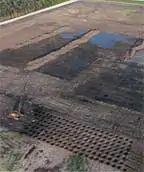
Deep Dynamic Compaction
Old landfills or dumps present some unique soil stability challenges. Deep dynamic compaction (DDC) is a ground stabilization technique that has gained popularity in recent years to improve subsurface soil conditions. DDC involves dropping 6 to 30-ton weights from a height between 30 and 75 feet to achieve the desired soil compaction. DDC can effectively apply to a range of subsurface materials, including former C&D debris or municipal solid waste dumps.
DDC provides a stable foundation for future development, minimizes differential settlement while leaving the landfill waste in place, and eliminates the costs associated with removing, transporting, and disposing of buried waste, costing millions of dollars. For simplicity’s sake, let’s consider a 1-acre old landfill or a dumpsite with an average of 15 feet of waste. If excavating the waste and replacing it with clean fill, the disposal fee costs for the excavated waste alone could exceed $400,000. Alternatively, DDC costs range from $1.50 to $2.00 per square foot or $65,000 to $87,120 per acre, excluding mobilization, which costs around $30,000.
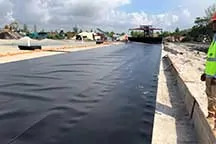
Gas Mitigation Systems
Constructing buildings on top of dynamically compacted areas generally requires a combustible gas barrier layer below the building foundation to manage subsurface combustible gases (typically methane). The barrier is required because the waste remains in place. In its simplified form, gas mitigation systems include:
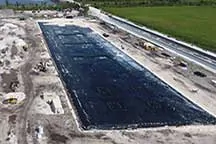
These gas mitigation systems can be either a passive or an active system with a blower. The cost of such systems varies depending on the size of the building, location, and type of liner system used. Typical capital costs for passive systems are in the range of $7 to $9 per square foot for the spray-applied liner and $3 to $4 per square foot for the HDPE liner. For an active system using blowers, add $3 to $4 per square foot. The designer configures a system from these options to address the client’s risk preference and considering future tenant preferences.
Using innovative approaches, impaired lands are increasingly attractive to developers. Beyond the cost-saving benefits to developers realized through DDC and an appropriate gas mitigation system, such projects also create local jobs, increase the tax base, and protect public health and the environment.
About the Authors:

At SCS, we’re proud that our services, vision, and corporate citizenship support community revitalization through brownfield redevelopment and land reuse.
The U.S. Environmental Protection Agency in 2017 estimated that roughly 40 percent of all Americans, including a quarter of all children, live within 3 miles of a brownfield site that has received EPA funding. This is a conservative estimate, as only 5.5% of brownfields nationwide have benefited from EPA resources. But these striking numbers clarify the degree to which remediating and repurposing contaminated and underutilized properties has transformative potential to protect our residents’ health and safety.
SCS firmly believes that all blighted, abandoned, and underutilized properties have a future as community assets. We support this vision through the services we provide as well as through our corporate citizenship. The partnership of SCS technology and environmental know-how with CCLR is powerful. There is no shortage of possibilities for brownfields now; ski resorts, parks, mixed-use properties, solar farms, really almost any infrastructure is possible.
SCS is proud to support the Center for Creative Land Recycling (CCLR, or “See Clear”), the leading national nonprofit dedicated to transforming communities through land recycling. Over the past two decades, CCLR has convened, navigated, and influenced the redevelopment industry. Their programs educate the public and community stakeholders to clean up and repurpose underutilized and environmentally impacted properties in a sustainable, equitable and responsible manner.
CCLR and SCS share the belief that with the right training, incentives, and conditions — chiefly, an active corporate partner/investor, community support, and municipal leadership — the redevelopment of brownfields changes communities for the better. CCLR has produced two videos, “About CCLR” and “What is Land Recycling?,” which provide important perspectives about CCLR’s mission and accomplishments.
Dan Johnson, Jim Ritchie, and Amy Dzialowski are among the SCS staff who have worked with CCLR. They have spoken on panels at CCLR’s California Land Recycling Conference, participated in vapor intrusion study groups, teamed with CCLR on providing technical support to West Sacramento and other municipalities, and serve on the planning committee for the Brownfields 2021 Conference together.
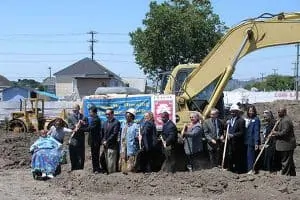
For more information about CCLR, brownfields, and property remediation, contact , or Jean Hamerman, Acting Executive Director of CCLR.
Shown here COMM22, developed by BRIDGE-Housing, is an award-winning mixed-use, mixed-income, transit-oriented development located at Commercial and 22nd streets in San Diego. SCS’s environmental remediation of the property to ensure human health and the environment were protected as cost-effectively as possible enabled the four-phase development project; supporting both the social and business goals of our client and the community.
Local governments and non-profits use Brownfields grants to complete environmental assessments, redevelopment planning, and environmental cleanup. The grant opportunities available now are as follows:
Brownfields Assessment Grant– for Brownfields inventories, environmental assessment, redevelopment planning, and cleanup planning. Funding amounts of $300,000 for community-wide and $600,000 for coalitions.
Brownfields Cleanup Grant– for environmental cleanup of a specific property or properties, currently owned by the applicant. Funding amounts up to $500,000
Brownfields Multi-Purpose Grant-for a range of activities including redevelopment planning, inventories, environmental assessment, and environmental cleanup. Funding amounts up to $800,000.
SCS Engineers has provided grant writing and implementation services for over $10 million in successful Brownfields grant applications including an 80% success rate for first-time applications and over 90% success rate for second round applications. Our Brownfields team is ready to support your grant application effort too. We will work with you to understand the EPA Brownfields grant opportunities and support your development of a successful proposal.
SCS Engineers is a national environmental consulting and contracting company with local experts. We serve as Brownfields’ consultants for many public and private sector clients. Find more inspiration and economic redevelopment successes across our nation:




Find a Brownfields consultant near you, try our staff directory where you can search by specialty, city, and state.
Shown here COMM22, developed by BRIDGE-Housing, is an award-winning mixed-use, mixed-income, transit-oriented development located at Commercial and 22nd streets in San Diego. SCS’s environmental remediation of the property to ensure human health and the environment were protected as cost-effectively as possible enabled the four-phase development project; supporting both the social and business goals of our client and the community.
Local governments and non-profits use these grants to complete environmental assessments, redevelopment planning, and environmental cleanup. The grant opportunities available now are as follows:
Brownfields Assessment Grant– for Brownfields inventories, environmental assessment, redevelopment planning, and cleanup planning. Funding amounts of $300,000 for community-wide and $600,000 for coalitions.
Brownfields Cleanup Grant– for environmental cleanup of a specific property or properties, currently owned by the applicant. Funding amounts up to $500,000
Brownfields Multi-Purpose Grant-for a range of activities including redevelopment planning, inventories, environmental assessment, and environmental cleanup. Funding amounts up to $800,000.
SCS Engineers has provided grant writing and implementation services for over $10 million in successful Brownfields grant applications including an 80% success rate for first-time applications and over 90% success rate for second round applications. Our Brownfields team is ready to support your grant application effort too. We will work with you to understand the EPA Brownfields grant opportunities and support your development of a successful proposal.
SCS Engineers is a national environmental consulting and contracting company with local experts. We serve as Brownfields’ consultants for many public and private sector clients. Find more inspiration and economic redevelopment successes across our nation:




Find a Brownfields consultant near you, try our staff directory where you can search by specialty, city, and state.
Joseph Dinan heads the SCS Engineers new office at 101 Arch Street, Boston, MA 02110,
Tel: 857-444-6302
SCS Engineers opened a new office in Boston’s Downtown Crossing district. The new location is more convenient for clients and enhances support to the firm’s growing client base in New England.
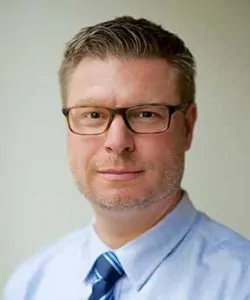
Joseph Dinan, an accomplished project manager and senior scientist heads Boston’s SCS team. Dinan has an excellent record meeting regulatory compliance and accountability for his clients to efficiently permit projects, keep them on budget and maintain the redevelopment schedule while meeting all environmental guidance. His background includes applied sciences including chemistry, microbiology, and environmental and soil sciences. Dinan has successfully managed hundreds of environmental assessment and remediation projects, both domestically and internationally.
Dinan’s Boston team resolves complex environmental challenges through the application of comprehensive analytical skills and technologies. Approaching each project with decades of expertise, mitigating the financial risk through careful assessment, analysis, and planning protects clients and the environment during all phases of redevelopment.
The Boston location supports the growing demand for environmental scientists, engineers, and consultants. SCS professional staff specializes in meeting federal, state, and local clean air, water, and soil goals, and the restoration of property once thought impractical to revitalize. The firm also provides vapor intrusion systems for protecting existing properties and a range of comprehensive environmental services for public and private entities.
As with most established urban environments, many properties may have previously been industrial or mass transportation sites, which often means that extra care is taken during redevelopment. Commercial real estate transactions must take environmental issues into consideration. Complex laws can impose significant environmental liabilities on purchasers, sellers, and lenders, whether or not they caused the problem, and whether or not they still own the property.
Important rules published by the U.S. Environmental Protection Agency – USEPA and in Massachusetts and other states offer defenses against environmental liabilities provided that the defendant conducted “all appropriate inquiries” regarding the property at the time of the acquisition, and then took reasonable steps to mitigate the effects of hazardous substances found on the property.
For more information, case studies, events, and articles visit these pages: